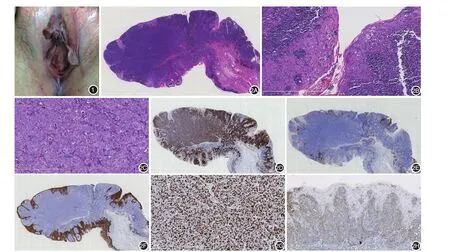Primary vulvar melanoma in a 27?year?old pregnant woman:a case report and literature review
Xian-Hong Yang,Yan Wang,Wei Zhang,Li-Ming Huang,Bao-Zhu Chang,Xue-Bao Shao,Fang Fang,Jian-Fang Sun*,Yi-Qun Jiang*
1Department of Dermatopathology,Hospital for Skin Diseases(Institute of Dermatology),Chinese Academy of Medical Sciences and Peking Union Medical College,Nanjing,Jiangsu 210042,China.2Department of Surgery,Hospital for Skin Diseases(Institute of Dermatology),Peking Union Medical College and Chinese Academy of Medical Sciences,Nanjing,Jiangsu 210042,China.3Department of Physiotherapy,Hospital for Skin Diseases(Institute of Dermatology),Peking Union Medical College and Chinese Academy of Medical Sciences,Nanjing,Jiangsu 210042,China.
Introduction
Vulvar melanoma is the second most common vulvar malignancy and a significant health issue in women.Despite its low incidence,vulvar melanoma has a poor prognosis with a high tendency to metastasize due to delayed diagnosis.Most women are postmenopausal and aged 50 to 70 years at the time of diagnosis[1].The occurrence of vulvar malignant melanoma(MM)at<30 years of age is extremely rare.We herein describe a case of primary vulvar MM in a 27-year-old woman during her first pregnancy.
Case report
A 27-year-old woman in the second week of her first gestation found a pigmented lesion on the right labium minora.She reported no pruritus or pain.The lesion gradually increased in size and became papillary.Sixteen weeks later,she presented to Hospital for Skin Diseases(Institute of Dermatology),Chinese Academy of Medical Sciences and Peking Union Medical College with pigmented papillomatosis of 5 mm×10 mm in diameter.The lesion was suspected to be condyloma accuminatum and was removed under local anesthesia.
Histological examination of the surgical specimen revealed melanocyte hyperplasia.Nests of proliferative melanocytes were seen in both epidermis and underlying dermis,and the edges of specimen were positive.The findings highly indicated MM,and atypical nevus during pregnancy was a differential diagnosis.Nuclear atypia and a few mitoses were observed in the deep portion of the dermal component.Immunohistochemical stains revealed moderate but diffuse expression of HMB-45,and p16 staining was negative.The Ki-67 proliferative index was about 30%.
Extended re-excision surgery was recommended,but the patient declined.She gave birth to a healthy infant by vaginal delivery at term.At this time,a pigmented vulvar lesion presented near the previously excised one.The placenta was normal on both gross and microscopic examination.She visited our clinic shortly after the delivery.Inspection of the external genitalia revealed an irregular dark lesion located on the right anterior part of the vulva,affecting both the labium minora and majora and measuring 20 mm×20 mm.No bleeding,ulceration,or exudation was observed(Figure 1).No lymph nodes were palpable in either side of the groin.Extensive partial excision of the vulva(partial right vulvectomy)was performed with a 2-cm-wide edge.Histopathological examination revealed proliferation of a large number of melanocytes in both the dermo-epidermal junction and dermis,with pagetoid spread upward in the superficial epidermis(Figure 2A and 2B).Melanocytes were distributed in sheets or nests and extended downward into the deep mid-dermis.Remarkable nuclear atypia was observed,and mitoses were commonly seen(12/mm2)(Figure 2C).Immunohistochemical analysis revealed diffusely positive staining with melan-A and HMB-45(Figure 2D);p16 staining was negative(Figure 2E).The Ki-67 proliferative index was 80%(Figure 2G).CD117 staining was moderately positive in both biopsies(Figure 2H).The histological diagnosis was MM TⅢ a,superficial spreading type,with a maximum Breslow thickness of3 mm and no ulceration.Groin ultrasonography revealed several enlarged bilateral lymph nodes;the largest was about 20 mm×16 mm.Lymph node biopsies did not confirm metastasis.Fluorescence in situ hybridization(FISH)analysis of theBRAF,NRUS,andC-KITgenes was performed with a melanoma FISH probe and revealed a genetic mutationinC-KIT(K642E).Other clinical examinations and imaging studies revealed no evidence of metastatic spread.

Figure 1 Pigmented lesion on the right anterior part of the vulva.The lesion involves both the labium majora and minora and has a diameter of 20 mm×20 mm with color variations.Figure 2 Histopathology of the lesion and immunohistochemical profiles.A:Low-power scanning reveals high-density melanocyte hyperplasia in both the epidermis and dermis(hematoxylin-eosin,×12.5).B:Pagetoid spreading of the melanocytes singly or in nests is observed(hematoxylineosin,×100).C:Sheets of atypical melanocytes deep in the dermis with mitoses are commonly seen(hematoxylin-eosin,×200).D:The melanocytes are positive for melan-A(immunohistochemistry,×12.5).E:The melanocytes are negative for p16(immunohistochemistry,×12.5).F:CK5/6 staining reveals consumption of the superimposed epidermis(immunohistochemistry,× 12.5).G:High Ki-67 index(immunohistochemistry,×100).H:CD117 staining is moderately positive(immunohistochemistry,×100).
After the operation,the patient was treated with interferon α2b therapy.During the first month,the interferon α2b was administered by intravenous injection at a dose of 1,800 IU/d for 5 days with a 2-day break per week.From the 2ndto the 12thmonth,the interferon α2b was reduced to 900 IU/d three times a week.The interferon α2b therapy continued for nearly 1 year until the occurrence of thyroid dysfunction,and then oral imatinib was given as a substitution for 3 months.The interferon therapy was then resumed and was still being continued at the time of this writing.No adverse reaction occurred.She has been clinically free of tumors for 24 months after the surgery.
Discussion
Vulvar MM during pregnancy is extremely rare.An extensive literature review revealed that only 4 cases have been reported since 1946[2-6].One case involved a 27-year-old patient complaint a firm mass of 4 cm on her right labium majora for years,and a biopsy during her pregnancy revealed melanoma[2].The patient underwent local excision without lymphadenectomy,2 years later she developed lymph node metastasis with subsequent remote metastasis,and died 3.5 years with multiple metastases.Dyduchet al.[3]described a 34-year-old patient with a pigmented lesion of 0.6 cm on the left labium majora 2 months before pregnancy.The lesion recurred twice during the pregnancy and after delivery,respectively,as a result of local excision with a margin of<0.5 cm.The Breslow thickness was<1 cm with ulceration.Neither sentinel lymph node(SLN)biopsy nor lymph node dissection was performed,and no long-term follow-up was recorded.Berlin and Winters[4]described a patient who survived for 6 years after surgery,and a 31-year-old Asian patient described in 1983 remained free of melanoma for 23 months of follow-up[5].These two patients had small lesions with a short duration and had undergone radical vulvectomy and lymph node dissection along with additional complemental therapy.
Two important points can be raised after comprehensive analysis of the above cases.First,nevi on the genitalia may have features simulating melanoma,and it has been noted that melanocytic nevi(MN)may enlarge and darken during pregnancy[6].Differentiation between vulvar melanoma in pregnancy and peculiar longstanding nevi in the vulvar region can be difficult,especially when the nevi on the vulva are large in size and have an irregular border and atypical pathology.Second,melanoma during pregnancy must be properly managed to improve the prognosis.
Prospective studies of pregnant women have shown no significant changes in MN during pregnancy except in women diagnosed with dysplastic nevus syndrome[7].One study revealed that dermoscopic changes in MN during pregnancy involved primarily expansion of anatomic locations.Driscoll and Grant-Kels[7]suggested that a changing melanocytic nevus during pregnancy should therefore not be considered to be physiologic,and prompt biopsy is indicated,just as in women who are not pregnant.Rapid growth and recent evolution are useful clues when MM is suspected.
Pathologically,genital nevi may show similar features of melanoma such as an increased cellular density,a few deeply situated mitoses,and ill-defined nests with regard to the intradermal component.Efforts have been made to differentiate the two conditions.Mihic-Probstet al.[8]confirmed that the absence of p16 immunostaining was associated with an increased proliferation rate and a strong argument for MM.They considered that the relevance of p16 could be an additional marker.Uguenet al.[9]explored a triple p16-Ki-67-HMB45 immunohistochemistry scoring system to assist the differential diagnosis between melanomas and nevi.They found that a high Ki-67 index,low to null of p16,and absence of HMB45 gradient were more frequent in melanomas than in nevi.
Genetic analyses of melanomas have revealed several recurrent aberrations that are absent in unequivocally benign lesions and have therefore been applied to differentiate them.A four-probe FISH assay targeting 6p25(RREB1),6q23(MYB),Cep6(centromere 6),and 11q13(CCND1)is being increasingly applied to distinguish between histologically unequivocal melanomas and nevi with high sensitivity and specificity[10].Furthermore,studies have disclosed distinct molecular alterations in melanoma arising from different anatomic sites[11-12].KITmutation was found to be significantly associated with vulvar melanoma,leading to the expansion of diagnostic and treatment options[13-15],but the prognostic value of theKITgene is controversial[14-15].
In the present case,the patient developed a rapidly evolving pigmented lesion with an unclear duration that later presented characteristics consistent with the“ABCD”criteria of MM when it recurred.The histopathological findings after the delivery confirmed the diagnosis of MM.KITmutation was detected.Immunohistochemical staining of CD117 revealed moderate but diffuse expression in both the original and recurrent lesions.The positive staining of CD117 supports the original consideration of MM combined with the histopathology result of HMB45 and Ki-67.
Melanomas arising in pregnancy have traditionally presented unique challenges not only because of the diagnostic dilemma,but also because they raise issues with respect to treatment and prognosis.For many years,there had been concern that the hormonal and immunological changes that occur during pregnancy may be disadvantageous in the evolution or progression of melanoma and lead to poorer outcomes.However,increasingly data have indicated that pregnancy before,during,or after a diagnosis of localized melanoma does not appear to affect the prognosis[16].The prognosis of vulvar MM is poor basically because of the biological aggressiveness of the neoplasm,occult occurrence,lack of early symptoms,thin underlying dermis,delayed diagnosis,and less radical surgical therapy.Compared with the more common subtype of MM in the Chinese(i.e.,acral type MM),our patient’s lesion showed more rapid progression and aggressive behavior.
No consensus regarding the most adequate staging system and treatment for neither vulvar melanoma nor melanoma in pregnancy has been reached.It is suggested that wide local excision may be safe under local anesthesia during pregnancy.For non-pregnant patients,SLN mapping and biopsy is recommended for melanomas with a Breslow thickness of≥1 mm or for thinner melanomas of Clark level Ⅳ/Ⅴ,mitoses,and microsatellites.For pregnant patients,SLN biopsy under local anesthesia should be postponed until the postpartum period except when the pregnancy involves enhanced lymphangiogenesis,which is associated with increased metastasis of melanoma.In such patients,timely SLN biopsy and lymph node dissection are indicated.Considering the Breslow thickness of 3 mm and stage of TⅢ a,partial vulvectomy with an excision margin of 2 cm without lymph node dissection was performed in our patient followed by interferon α2b treatment for almost 24 months,and the patient was free of melanoma at the time of this writing.Under the same surgical guideline,the 34-year-old patient described by Dyduchet al.[3]had a maximum Breslow depth of 0.9 mm,and a margin of 1 cm was theoretically suitable;this may explain the consecutive recurrence.
In summary,vulvar melanoma during pregnancy is very rare.The diagnosis may be a great dilemma because vulvar melanoma is difficult to differentiate from a peculiar nevus.Overdiagnosis or misdiagnosis can lead to inappropriate outcomes.Our literature review indicates that recent and rapid evolution of a pigmented lesion and cytological atypia in the deep dermis are indicative of MM.Immunohistochemical staining with high expression of Ki-67 and negative expression of p16 support the diagnosis of MM.Additionally,FISH detection of genomic expansion or activated mutations of certain genes may confirm the diagnosis.Surgical resection of vulva with 2-cm margins along with adjuvant immunotherapy leads to a relatively good prognosis.
Acknowledgment
This work was supported by the CAMS Innovation Fund for Medical Sciences(CIFMS-2017-I2M-1-017).
- 國際皮膚性病學雜志的其它文章
- Paraneoplastic pemphigus comorbid with cardiac cancer and duodenal gastrointestinal stromal tumors:a rare case report
- Reactive perforating collagenosis
- Sun?protection knowledge and strategies of Chinese dermatologists:a nation?wide,questionnaire?based survey
- Initial presentation of acute myeloid leukemia in a patient with cutaneous myeloid sarcoma
- Persistent papules with adult?onset Still’s disease:a case report
- Cutaneous plexiform schwannoma in the right thigh after trauma

